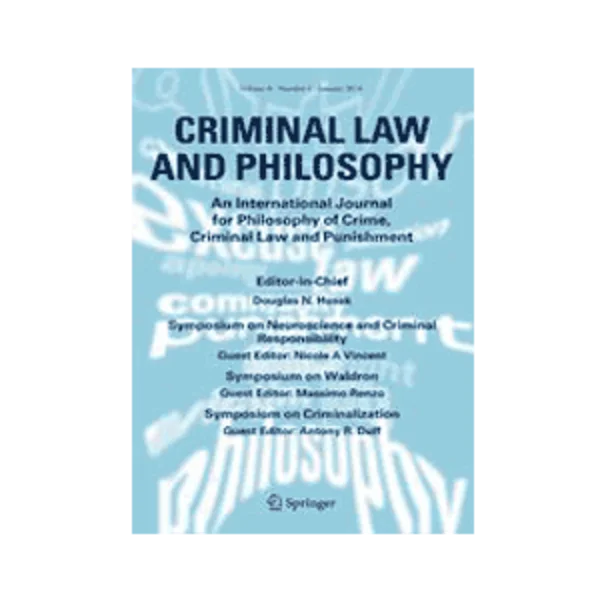-
the significance of transferred intent
جزئیات بیشتر مقاله- تاریخ ارائه: 1392/07/24
- تاریخ انتشار در تی پی بین: 1392/07/24
- تعداد بازدید: 1010
- تعداد پرسش و پاسخ ها: 0
- شماره تماس دبیرخانه رویداد: -
the significance of transferred intentthe doctrine of transferred intent (or transferred “malice” in england) generally provides that if a attempts to harm b but, because of bad aim, misses and accidentally causes the same harm to befall c, a’s harmful intent vis-à-vis b is transferred to c, thus rendering a guilty of intentionally harming c. commentators acknowledge the doctrine to be a legal fiction, but they differ regarding whether the fiction produces just results, some believing it does, others believing that a is guilty at most of attempting to harm b rather than intentionally harming c. commentators who agree that the fiction produces just results nevertheless differ regarding whether the fiction should be retained or whether a’s intent to harm “a” person, in this case, b, is the only intent that signifies for crimes of intentional harm, regardless of whom a eventually harms. doug husak sought to achieve reflective equilibrium between intuition and theory regarding bad-aim cases by proposing in 1996 that a be punished for attempting to harm b (rather than for harming c) but sentenced as if he had harmed b. i once believed that husak was correct. but i now have doubts, in part because husak, along with others, cannot explain why the strength of people’s intuitions regarding a’s responsibility in bad-aim cases depends upon (1) c’s being a reasonably foreseeable victim, and (2) c’s being harmed by the same threat of force that a initially unleashed against b. i argue that one cannot achieve reflective equilibrium in bad-aim cases without inquiring into why resulting harm matters in criminal law, and that when one does, one discovers that just as people’s intuitions regarding whether intentional harms are proximate depend upon how resulting harms occur, so, too, people’s intuitions regarding whether an actor is guilty of intentional harm depend upon how resulting harm comes about.
مقالات جدیدترین رویدادها
-
استفاده از تحلیل اهمیت-عملکرد در ارائه الگوی مدیریت خلاقیت سازمانی و ارائه راهکار جهت بهبود
-
بررسی تاثیر ارزش وجوه نقد مازاد بر ساختار سرمایه شرکت های پذیرفته شده در بورس اوراق بهادار تهران
-
بررسی تأثیر سطح افشای ریسک بر قرارداد بدهی شرکت های پذیرفته شده در بورس اوراق بهادار تهران
-
بررسی تأثیر رتبه بندی اعتباری مبتنی بر مدل امتیاز بازار نوظهور بر نقد شوندگی سهام با تأکید بر خصوصی سازی شرکت ها
-
تأثیر آمیخته بازاریابی پوشاک ایرانی بر تصویر ذهنی مشتری پوشاک ایرانی (هاکوپیان)
-
شناسایی و اولویت بندی عوامل مؤثر بر چابکی سازمان با استفاده از تکنیک سلسله مراتبی فازی (موردمطالعه: شرکت ماموت)
-
نقش معماری منازل مسکونی در تربیت فرزندان
-
بررسی تجربی رفتار برشگیرهای به شکل ناودانی نبشی و برشگیر t شکل
-
بررسی ظرفیت باربری نوک شمع در خاک های لایه ای
-
adsorption of 2- methyl-n-(2´-aminoethyl)-3-hydroxyl-4-pyridinone onto functionalized single-walled carbon nanotube: a dft study
مقالات جدیدترین ژورنال ها
-
مدیریت و بررسی افسردگی دانش آموزان دختر مقطع متوسطه دوم در دروان کرونا در شهرستان دزفول
-
مدیریت و بررسی خرد سیاسی در اندیشه ی فردوسی در ادب ایران
-
واکاوی و مدیریت توصیفی قلمدان(جاکلیدی)ضریح در موزه آستان قدس رضوی
-
بررسی تاثیر خلاقیت، دانش و انگیزه کارکنان بر پیشنهادات نوآورانه کارکنان ( مورد مطالعه: هتل های 3 و 4 ستاره استان کرمان)
-
بررسی تاثیر کیفیت سیستم های اطلاعاتی بر تصمیم گیری موفق در شرکتهای تولیدی استان اصفهان (مورد مطالعه: مدیران شرکتهای تولیدی استان اصفهان)
-
درآمدی بر اهمیت فرآورده ها و مشتقات محصولی میوه انار برای مدیریت مسائل انسانی
-
مطالعه تأثیر عدم تقارن اطلاعاتی بر رابطه بین همزمانی قیمت و نقدشوندگی سهام
-
تضمین های حقوق شهروندی متهمان جرایم تروریستی در مرحله تحقیقات؛ مطالعه تطبیقی در حقوق ایران، انگلستان و مصر
-
مقایسه نیروی ترک خوردگی در تیرهای مقاوم سازی شده با hpfrcc نسبت به تیر نمونه مرجع
-
تحلیل و بررسی توسعه فناوری و اهداف اقتصادی دولت اسلامی




سوال خود را در مورد این مقاله مطرح نمایید :